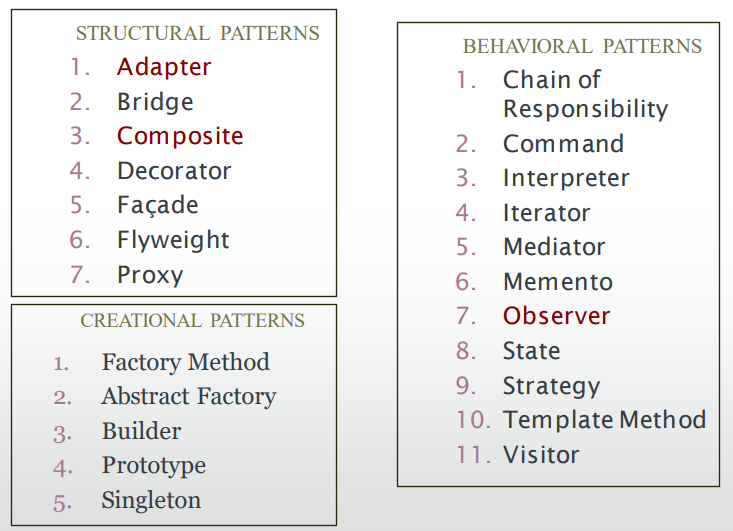- What is the Design Patterns?
- What is a Pattern?
- Different Types of Patterns
- Good design principles
- Good use of Design Pattern Principles
What is the Design Patterns?
- Describes a problem which frequently occurs in our environment, and then describes the core of the solution to the problem
- Software development is repetitive: Quite often, different programmers have to solve the similar problems.
- Experienced programmers have compared notes and discovered that they arrived at common solutions to the same problems
-
Over time, these common solutions have been systematically documented as the best known approach to solving a given problem
- A good pattern should
- Be as general as possible
- Contain a solution that has been proven to effectively solve the problem in the indicated context.
- In order to benefit you must know:
- The problem you are facing
- Know design patterns themselves
- Key is to understand the relationship between classes and how to allocate responsibilities to them
- There are currently over 100 documented design patterns. The classic book, “Design Patterns: Elements of Reusable Object-Oriented Software” was written by Gamma, Helm, Johnson, and Vlissides (called the Gang of four) covers 23 patterns which have been chosen.
What is a Pattern?
There are 4 essential elements of a design pattern:
- Pattern name
- Problem description
- This describes when the pattern can be applied: to what kind of problem, and what pre-conditions need to be met
- Solution description
- An abstract description of the solution in terms of a set of classes with particular functionalities and interrelationships
- Consequences
- presenting the results and tradeoffs of using the pattern, helping you decide the best choice from among several promising alternatives.
Different Types of Patterns
Creational patterns
- The process of object construction and the instantiation process
- Example: the Singleton pattern is for a class that has only one instance
- Example: the Abstract Factory pattern provides an interface for creating families of related or dependent objects without specifying their concrete class.
- Example: the Factory Method pattern defines an interface for creating an object of some class but defers instantiation to subclasses
Structural Patterns
- Composition of classes/objects: how classes and objects are composed to form larger structures
- Example: the Adapter pattern converts the interface of a class into another interface clients expect.
- Example: the Composite pattern composes objects into tree-structures to represent part/whole relationships and lets clients treat individuals and groups uniformly.
- Example: the Decorator pattern attaches additional responsibility to an object dynamically – more flexibly than sub-classing.
Behavioural Patterns
- The way classes and objects interact/patterns of communication between classes
- Example: the Iterator pattern provides an interface for accessing elements of an aggregate, such as a vector or a list, without exposing the aggregates interface or internal structure.
- Example: the Observer pattern defines a 1 to many dependency between objects so that when one changes state, all dependents are notified and updated.
Good design principles
- Program to interfaces not to an implementation
- Separate what changes from what does not
- Loose couple objects that interact
- Classes should be open for extension, but closed for modification
- Each class should have one responsibility
- Depend on abstractions, not concrete classes
Good use of Design Pattern Principles
- Let design patterns emerge from your design, don’t use them just because you should
- Always choose the simplest solution that meets your need
- Always use the pattern if it simplifies the solution
- Know a good list of the design patterns out there

